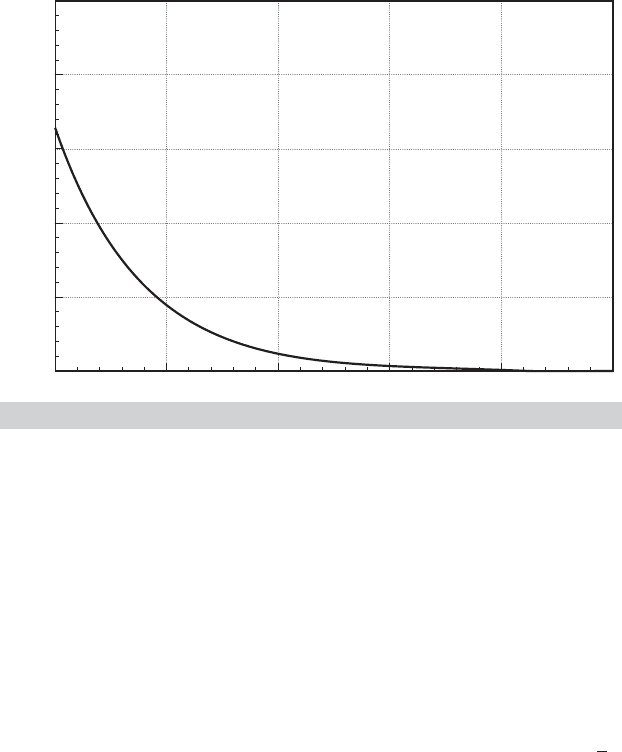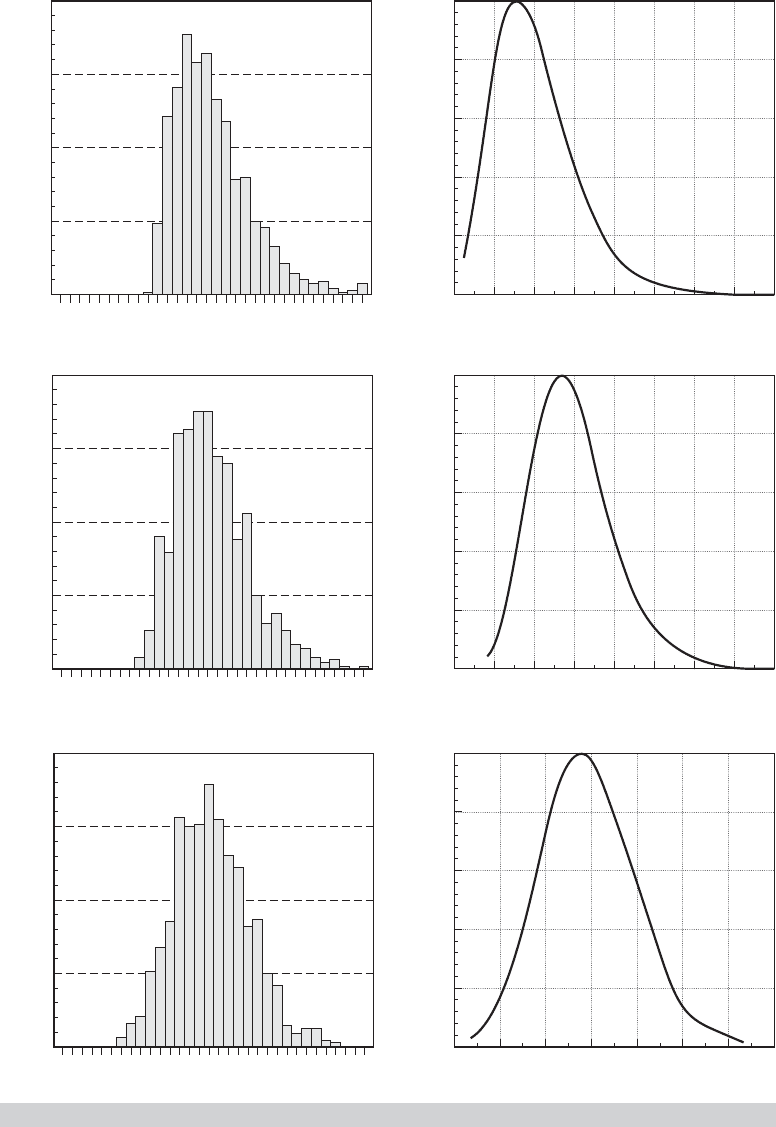Greene W.H. Econometric Analysis
Подождите немного. Документ загружается.


APPENDIX D
✦
Large-Sample Distribution Theory
1079
a well-defined limiting distribution. To jump to the most common application, whereas
plim
ˆ
θ
n
= θ,
we often find that
z
n
=
√
n(
ˆ
θ
n
− θ)
d
−→ f (z),
where f (z) is a well-defined distribution with a mean and a positive variance. An estimator
which has this property is said to be root-n consistent. The single most important theorem in
econometrics provides an application of this proposition. A basic form of the theorem is as
follows.
THEOREM D.18
Lindeberg–Levy Central Limit Theorem
(Univariate)
If x
1
,...,x
n
are a random sample from a probability distribution with finite
mean μ and finite variance σ
2
and ¯x
n
= (1/n)
n
i=1
x
i
, then
√
n( ¯x
n
− μ)
d
−→ N[0,σ
2
],
A proof appears in Rao (1973, p. 127).
The result is quite remarkable as it holds regardless of the form of the parent distribution. For
a striking example, return to Figure C.2. The distribution from which the data were drawn in that
figure does not even remotely resemble a normal distribution. In samples of only four observations
the force of the central limit theorem is clearly visible in the sampling distribution of the means.
The sampling experiment Example D.6 shows the effect in a systematic demonstration of the
result.
The Lindeberg–Levy theorem is one of several forms of this extremely powerful result. For
our purposes, an important extension allows us to relax the assumption of equal variances. The
Lindeberg–Feller form of the central limit theorem is the centerpiece of most of our analysis in
econometrics.
THEOREM D.19
Lindeberg–Feller Central Limit Theorem
(with Unequal Variances)
Suppose that {x
i
}, i = 1,...,n, is a sequence of independent random variables with finite
means μ
i
and finite positive variances σ
2
i
. Let
¯μ
n
=
1
n
(μ
1
+ μ
2
+···+μ
n
), and ¯σ
2
n
=
1
n
σ
2
1
+ σ
2
2
+···,σ
2
n
.
If no single term dominates this average variance, which we could state as lim
n→∞
max(σ
i
)/
(n ¯σ
n
) =0, and if the average variance converges to a finite constant, ¯σ
2
= lim
n→∞
¯σ
2
n
,
then
√
n( ¯x
n
− ¯μ
n
)
d
−→ N[0, ¯σ
2
].

1080
PART VI
✦
Appendices
0
0.0
1.0
0.8
0.6
0.4
0.2
2
Density
4
Density of Exponential (Mean 1.5)
6810
FIGURE D.2
The Exponential Distribution.
In practical terms, the theorem states that sums of random variables, regardless of their form,
will tend to be normally distributed. The result is yet more remarkable in that it does not require
the variables in the sum to come from the same underlying distribution. It requires, essentially, only
that the mean be a mixture of many random variables, none of which is large compared with their
sum. Because nearly all the estimators we construct in econometrics fall under the purview of the
central limit theorem, it is obviously an important result.
Example D.6 The Lindeberg–Levy Central Limit Theorem
We’ll use a sampling experiment to demonstrate the operation of the central limit theorem.
Consider random sampling from the exponential distribution with mean 1.5—this is the setting
used in Example C.4. The density is shown in Figure D.2.
We’ve drawn 1,000 samples of 3, 6, and 20 observations from this population and com-
puted the sample means for each. For each mean, we then computed z
in
=
√
n(¯x
in
− μ),
where i =1, ..., 1,000 and n is 3, 6 or 20. The three rows of figures in Figure D.3 show
histograms of the observed samples of sample means and kernel density estimates of the
underlying distributions for the three samples of transformed means.
Proof of the Lindeberg–Feller theorem requires some quite intricate mathematics [see, e.g.,
Loeve (1977)] that are well beyond the scope of our work here. We do note an important consid-
eration in this theorem. The result rests on a condition known as the Lindeberg condition. The
sample mean computed in the theorem is a mixture of random variables from possibly different
distributions. The Lindeberg condition, in words, states that the contribution of the tail areas
of these underlying distributions to the variance of the sum must be negligible in the limit. The
condition formalizes the assumption in Theorem D.19 that the average variance be positive and
not be dominated by any single term. [For an intuitively crafted mathematical discussion of this
condition, see White (2001, pp. 117–118).] The condition is essentially impossible to verify in
practice, so it is useful to have a simpler version of the theorem that encompasses it.

4.000
0
140
105
70
35
Frequency
2.857 2.8571.714
Histogram for Variable z
3
z
3
1.7140.571 0.571 4.000
4.000 2.857 2.8571.714 1.7140.571 0.571 4.000
4.000 2.857 2.8571.714 1.7140.571 0.571 4.000
0
128
96
64
32
Frequency
Histogram for Variable z
6
z
6
0
124
93
62
31
Frequency
Histogram for Variable z
20
z
20
Density
Kernel Density Estimate for z
3
z
3
2 10
0.00
123456
0.43
0.34
0.26
0.17
0.09
Density
Kernel Density Estimate for z
6
z
6
3 2 1
0.00
012345
0.42
0.33
0.25
0.17
0.08
Density
Kernel Density Estimate for z
20
z
20
3 2 1
0.00
01234
0.39
0.31
0.23
0.15
0.08
FIGURE D.3
The Central Limit Theorem.
1081

1082
PART VI
✦
Appendices
THEOREM D.20
Liapounov Central Limit Theorem
Suppose that {x
i
} is a sequence of independent random variables with finite means μ
i
and
finite positive variances σ
2
i
such that E[|x
i
−μ
i
|
2+δ
] is finite for some δ>0.If ¯σ
n
is positive
and finite for all n sufficiently large, then
√
n( ¯x
n
− ¯μ
n
)/ ¯σ
n
d
−→ N[0, 1].
This version of the central limit theorem requires only that moments slightly larger than two be
finite.
Note the distinction between the laws of large numbers in Theorems D.5 and D.6 and the
central limit theorems. Neither asserts that sample means tend to normality. Sample means (i.e.,
the distributions of them) converge to spikes at the true mean. It is the transformation of the
mean,
√
n( ¯x
n
−μ)/σ, that converges to standard normality. To see this at work, if you have access
to the necessary software, you might try reproducing Example D.6 using the raw means, ¯x
in
. What
do you expect to observe?
For later purposes, we will require multivariate versions of these theorems. Proofs of the
following may be found, for example, in Greenberg and Webster (1983) or Rao (1973) and
references cited there.
THEOREM D.18A
Multivariate Lindeberg–Levy Central
Limit Theorem
If x
1
,...,x
n
are a random sample from a multivariate distribution with finite mean vector
μ and finite positive definite covariance matrix Q, then
√
n(
¯
x
n
− μ)
d
−→ N[0, Q],
where
¯
x
n
=
1
n
n
i=1
x
i
.
To get from D.18 to D.18A (and D.19 to D.19A) we need to add a step. Theorem D.18
applies to the individual elements of the vector. A vector has a multivariate normal distri-
bution if the individual elements are normally distributed and if every linear combination
is normally distributed. We can use Theorem D.18 (D.19) for the individual terms and
Theorem D.17 to establish that linear combinations behave likewise. This establishes the
extensions.
The extension of the Lindeberg–Feller theorem to unequal covariance matrices requires
some intricate mathematics. The following is an informal statement of the relevant conditions.
Further discussion and references appear in Fomby, Hill, and Johnson (1984) and Greenberg and
Webster (1983).

APPENDIX D
✦
Large-Sample Distribution Theory
1083
THEOREM D.19A
Multivariate Lindeberg–Feller Central
Limit Theorem
Suppose that x
1
,...,x
n
are a sample of random vectors such that E[x
i
] = μ
i
,
Var[x
i
] = Q
i
, and all mixed third moments of the multivariate distribution are finite.
Let
¯μ
n
=
1
n
n
i=1
μ
i
,
¯
Q
n
=
1
n
n
i=1
Q
i
.
We assume that
lim
n→∞
¯
Q
n
= Q,
where Q is a finite, positive definite matrix, and that for every i,
lim
n→∞
(n
¯
Q
n
)
−1
Q
i
= lim
n→∞
n
i=1
Q
i
−1
Q
i
= 0.
We allow the means of the random vectors to differ, although in the cases that we will
analyze, they will generally be identical. The second assumption states that individual
components of the sum must be finite and diminish in significance. There is also an im-
plicit assumption that the sum of matrices is nonsingular. Because the limiting matrix is
nonsingular, the assumption must hold for large enough n, which is all that concerns us
here. With these in place, the result is
√
n(
¯
x
n
− ¯μ
n
)
d
−→ N[0, Q].
D.2.7 THE DELTA METHOD
At several points in Appendix C, we used a linear Taylor series approximation to analyze the
distribution and moments of a random variable. We are now able to justify this usage. We complete
the development of Theorem D.12 (probability limit of a function of a random variable), Theorem
D.16 (2) (limiting distribution of a function of a random variable), and the central limit theorems,
with a useful result that is known as the delta method. For a single random variable (sample mean
or otherwise), we have the following theorem.
THEOREM D.21
Limiting Normal Distribution of a Function
If
√
n(z
n
− μ)
d
−→ N[0,σ
2
] and if g(z
n
) is a continuous and continuously differentiable
function with g
(μ) not equal to zero and not involving n, then
√
n[g(z
n
) − g(μ)]
d
−→ N[0, {g
(μ)}
2
σ
2
]. (D-18)

1084
PART VI
✦
Appendices
Notice that the mean and variance of the limiting distribution are the mean and variance of
the linear Taylor series approximation:
g(z
n
) g(μ) + g
(μ)(z
n
− μ).
The multivariate version of this theorem will be used at many points in the text.
THEOREM D.21A
Limiting Normal Distribution of a Set
of Functions
If z
n
is a K × 1 sequence of vector-valued random variables such that
√
n(z
n
− μ)
d
−→
N[0, ] and if c(z
n
) is a set of J continuous and continuously differentiable functions of
z
n
with C(μ) not equal to zero, not involving n, then
√
n[c(z
n
) − c(μ)]
d
−→ N[0, C(μ)C(μ)
], (D-19)
where C(μ) is the J × K matrix ∂c(μ)/∂μ
. The jth row of C(μ) is the vector of partial
derivatives of the jth function with respect to μ
.
D.3 ASYMPTOTIC DISTRIBUTIONS
The theory of limiting distributions is only a means to an end. We are interested in the behavior of
the estimators themselves. The limiting distributions obtained through the central limit theorem
all involve unknown parameters, generally the ones we are trying to estimate. Moreover, our
samples are always finite. Thus, we depart from the limiting distributions to derive the asymptotic
distributions of the estimators.
DEFINITION D.12
Asymptotic Distribution
An asymptotic distribution is a distribution that is used to approximate the true finite sample
distribution of a random variable.
5
By far the most common means of formulating an asymptotic distribution (at least by econo-
metricians) is to construct it from the known limiting distribution of a function of the random
variable. If
√
n[( ¯x
n
− μ)/σ ]
d
−→ N[0, 1],
5
We depart somewhat from some other treatments [e.g., White (2001), Hayashi (2000, p. 90)] at this point,
because they make no distinction between an asymptotic distribution and the limiting distribution, although
the treatments are largely along the lines discussed here. In the interest of maintaining consistency of the
discussion, we prefer to retain the sharp distinction and derive the asymptotic distribution of an estimator, t
by first obtaining the limiting distribution of
√
n(t − θ). By our construction, the limiting distribution of t is
degenerate, whereas the asymptotic distribution of
√
n(t − θ) is not useful.

APPENDIX D
✦
Large-Sample Distribution Theory
1085
0 0.5
0.25
1.75
1.50
Asymptotic
distribution
1.25
1.00
0.75
0.50
1.0 1.5 2.0 2.5 3.0
Exact
distribution
f(x
n
)
x
n
FIGURE D.4
True Versus Asymptotic Distribution.
then approximately, or asymptotically, ¯x
n
∼ N[μ, σ
2
/n], which we write as
¯x
a
∼
N[μ, σ
2
/n].
The statement “ ¯x
n
is asymptotically normally distributed with mean μ and variance σ
2
/n” says
only that this normal distribution provides an approximation to the true distribution, not that the
true distribution is exactly normal.
Example D.7 Asymptotic Distribution of the Mean of an
Exponential Sample
In sampling from an exponential distribution with parameter θ, the exact distribution of ¯x
n
is that of θ/(2n) times a chi-squared variable with 2n degrees of freedom. The asymptotic
distribution is N[θ, θ
2
/n]. The exact and asymptotic distributions are shown in Figure D.4 for
the case of θ = 1 and n = 16.
Extending the definition, suppose that
ˆ
θ
n
is an estimator of the parameter vector θ.The
asymptotic distribution of the vector
ˆ
θ
n
is obtained from the limiting distribution:
√
n(
ˆ
θ
n
− θ)
d
−→ N[0, V] (D-20)
implies that
ˆ
θ
n
a
∼
N
θ,
1
n
V
. (D-21)
This notation is read “
ˆ
θ
n
is asymptotically normally distributed, with mean vector θ and covariance
matrix (1/n)V.” The covariance matrix of the asymptotic distribution is the asymptotic covariance
matrix and is denoted
Asy. Var[
ˆ
θ
n
] =
1
n
V.

1086
PART VI
✦
Appendices
Note, once again, the logic used to reach the result; (D-20) holds exactly as n →∞. We assume
that it holds approximately for finite n, which leads to (D-21).
DEFINITION D.13
Asymptotic Normality and Asymptotic
Efficiency
An estimator
ˆ
θ
n
is asymptotically normal if (D-20) holds. The estimator is asymptotically ef-
ficient if the covariance matrix of any other consistent, asymptotically normally distributed
estimator exceeds (1/n)V by a nonnegative definite matrix.
For most estimation problems, these are the criteria used to choose an estimator.
Example D.8 Asymptotic Inefficiency of the Median in
Normal Sampling
In sampling from a normal distribution with mean μ and variance σ
2
, both the mean ¯x
n
and
the median M
n
of the sample are consistent estimators of μ. The limiting distributions of both
estimators are spikes at μ, so they can only be compared on the basis of their asymptotic
properties. The necessary results are
¯x
n
a
∼
N[μ, σ
2
/n], and M
n
a
∼
N[μ,(π/2) σ
2
/n]. (D-22)
Therefore, the mean is more efficient by a factor of π/2. (But, see Example 15.7 for a finite
sample result.)
D.3.1 ASYMPTOTIC DISTRIBUTION OF A NONLINEAR FUNCTION
Theorems D.12 and D.14 for functions of a random variable have counterparts in asymptotic
distributions.
THEOREM D.22
Asymptotic Distribution of a Nonlinear Function
If
√
n(
ˆ
θ
n
−θ)
d
−→ N[0,σ
2
] and if g(θ) is a continuous and continuously differentiable func-
tion with g
(θ) not equal to zero and not involving n, then g(
ˆ
θ
n
)
a
∼
N[g(θ), (1/n){g
(θ)}
2
σ
2
].
If
ˆ
θ
n
is a vector of parameter estimators such that
ˆ
θ
n
a
∼
N[θ,(1/n)V] and if c(θ ) is a set of
J continuous functions not involving n, then c(
ˆ
θ
n
)
a
∼
N[c(θ), (1/n)C(θ)VC(θ)
], where
C(θ) = ∂c(θ )/∂θ
.
Example D.9 Asymptotic Distribution of a Function of Two Estimators
Suppose that b
n
and t
n
are estimators of parameters β and θ such that
b
n
t
n
a
∼
N
β
θ
,
σ
ββ
σ
βθ
σ
θβ
σ
θθ
.
Find the asymptotic distribution of c
n
= b
n
/(1−t
n
). Let γ = β/(1−θ ) . By the Slutsky theorem,
c
n
is consistent for γ . We shall require
∂γ
∂β
=
1
1 − θ
= γ
β
,
∂γ
∂θ
=
β
(1− θ )
2
= γ
θ
.

APPENDIX D
✦
Large-Sample Distribution Theory
1087
Let be the 2 ×2 asymptotic covariance matrix given previously. Then the asymptotic
variance of c
n
is
Asy. Var[c
n
] = (γ
β
γ
θ
)
γ
β
γ
θ
= γ
2
β
σ
ββ
+ γ
2
θ
σ
θθ
+ 2γ
β
γ
θ
σ
βθ
,
which is the variance of the linear Taylor series approximation:
ˆγ
n
γ + γ
β
(b
n
− β) + γ
θ
(t
n
− θ).
D.3.2 ASYMPTOTIC EXPECTATIONS
The asymptotic mean and variance of a random variable are usually the mean and variance of
the asymptotic distribution. Thus, for an estimator with the limiting distribution defined in
√
n(
ˆ
θ
n
− θ)
d
−→ N[0, V],
the asymptotic expectation is θ and the asymptotic variance is (1/n)V. This statement implies,
among other things, that the estimator is “asymptotically unbiased.”
At the risk of clouding the issue a bit, it is necessary to reconsider one aspect of the previous
description. We have deliberately avoided the use of consistency even though, in most instances,
that is what we have in mind. The description thus far might suggest that consistency and asymp-
totic unbiasedness are the same. Unfortunately (because it is a source of some confusion), they are
not. They are if the estimator is consistent and asymptotically normally distributed, or CAN. They
may differ in other settings, however. There are at least three possible definitions of asymptotic
unbiasedness:
1. The mean of the limiting distribution of
√
n(
ˆ
θ
n
− θ) is 0.
2. lim
n→∞
E[
ˆ
θ
n
] = θ. (D-23)
3. plim θ
n
= θ.
In most cases encountered in practice, the estimator in hand will have all three properties, so
there is no ambiguity. It is not difficult to construct cases in which the left-hand sides of all
three definitions are different, however.
6
There is no general agreement among authors as to the
precise meaning of asymptotic unbiasedness, perhaps because the term is misleading at the outset;
asymptotic refers to an approximation, whereas unbiasedness is an exact result.
7
Nonetheless, the
majority view seems to be that (2) is the proper definition of asymptotic unbiasedness.
8
Note,
though, that this definition relies on quantities that are generally unknown and that may not exist.
A similar problem arises in the definition of the asymptotic variance of an estimator. One
common definition is
9
Asy. Var[
ˆ
θ
n
] =
1
n
lim
n→∞
E
√
n
ˆ
θ
n
− lim
n→∞
E [
ˆ
θ
n
]
2
. (D-24)
6
See, for example, Maddala (1977a, p. 150).
7
See, for example, Theil (1971, p. 377).
8
Many studies of estimators analyze the “asymptotic bias” of, say,
ˆ
θ
n
as an estimator of a parameter θ.In
most cases, the quantity of interest is actually plim [
ˆ
θ
n
− θ]. See, for example, Greene (1980b) and another
example in Johnston (1984, p. 312).
9
Kmenta (1986, p.165).

1088
PART VI
✦
Appendices
This result is a leading term approximation, and it will be sufficient for nearly all applications.
Note, however, that like definition 2 of asymptotic unbiasedness, it relies on unknown and possibly
nonexistent quantities.
Example D.10 Asymptotic Moments of the Sample Variance
The exact expected value and variance of the variance estimator
m
2
=
1
n
n
i =1
( x
i
− ¯x )
2
(D-25)
are
E [m
2
] =
(n − 1) σ
2
n
, (D-26)
and
Var [m
2
] =
μ
4
− σ
4
n
−
2(μ
4
− 2σ
4
)
n
2
+
μ
4
− 3σ
4
n
3
, (D-27)
where μ
4
= E [( x −μ)
4
]. [See Goldberger (1964, pp. 97–99).] The leading term approximation
would be
Asy. Var [m
2
] =
1
n
(μ
4
− σ
4
).
D.4 SEQUENCES AND THE ORDER
OF A SEQUENCE
This section has been concerned with sequences of constants, denoted, for example, c
n
, and
random variables, such as x
n
, that are indexed by a sample size, n. An important characteristic of
a sequence is the rate at which it converges (or diverges). For example, as we have seen, the mean
of a random sample of n observations from a distribution with finite mean, μ, and finite variance,
σ
2
, is itself a random variable with variance γ
2
n
= σ
2
/n. We see that as long as σ
2
is a finite
constant, γ
2
n
is a sequence of constants that converges to zero. Another example is the random
variable x
(1),n
, the minimum value in a random sample of n observations from the exponential
distribution with mean 1/θ defined in Example C.4. It turns out that x
(1),n
has variance 1/(nθ)
2
.
Clearly, this variance also converges to zero, but, intuition suggests, faster than σ
2
/n does. On
the other hand, the sum of the integers from one to n, S
n
= n(n + 1)/2, obviously diverges as
n →∞, albeit faster (one might expect) than the log of the likelihood function for the exponential
distribution in Example C.6, which is ln L(θ ) = n(ln θ − θ ¯x
n
). As a final example, consider the
downward bias of the maximum likelihood estimator of the variance of the normal distribution,
c
n
= (n − 1)/n, which is a constant that converges to one. (See Example C.5.)
We will define the rate at which a sequence converges or diverges in terms of the order of
the sequence.
DEFINITION D.14
Order n
δ
A sequence c
n
is of order n
δ
, denoted O(n
δ
), if and only if plim(1/n
δ
)c
n
is a finite nonzero
constant.
